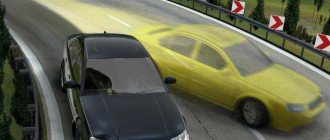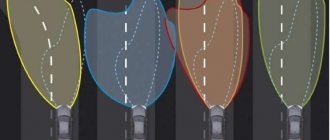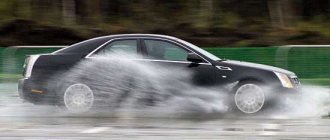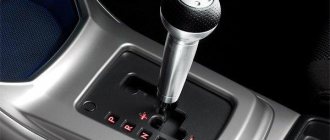Crossovers (CUV) and sport utility vehicles (SUV) are vehicles with improved cross-country ability compared to classic passenger cars (sedans, station wagons, hatchbacks). They have a large number of similar features. Crossovers, in fact, are lightweight versions of all-terrain vehicles, better suited for urban use.
Some models of the CUV segment (for example, Land Rover Freelander) are close in spirit to representatives of the SUV class. For other crossovers, their closest relatives are passenger cars. They have less weight, are more comfortable on asphalt roads, and have increased fuel efficiency. They are very different from SUVs.
What is an SUV?
SUVs are vehicles with powerful engines, rugged construction, and high ground clearance. This transport is often used by government services, law enforcement agencies and the military.
This category gained its popularity due to its high cross-country ability not only on dirt roads, but also on actual off-road conditions. That is, SUVs can handle mud, snow, ice, steep slopes and other terrain features quite easily.
The main features that characterize the SUV are:
- permanent or rigidly connected all-wheel drive;
- gasoline or diesel engine;
- one-piece frame at the base of the body, made of durable materials;
- Gearbox with a number of low gears;
- possibility of locking differentials;
- wheel diameter from 30 inches;
- high ground clearance (from 20 cm and above).
Also, the features include the geometric shapes of the transport, which allow SUVs to move in almost all driving conditions.
Reference.
During the collapse of the USSR, when the first foreign passenger SUVs began to appear in the country, this category began to be called jeeps. This is a common noun. Jeep is one of the car brands produced by Chrysler.
The most popular cars of this classification:
Crossovers and their features
Crossovers quickly gained popularity, as they have high levels of comfort and convenience during movement. This type of car is designed to travel mainly on roads, and occasionally on dirt roads. Essentially, a crossover is a passenger car with more capabilities. This category is often confused with SUVs due to their large dimensions.
Distinctive features of crossovers:
- Gearbox without low gears;
- all-wheel drive is activated automatically when the drive axle slips or is absent altogether;
- ground clearance is less than that of SUVs, but greater than that of passenger cars;
- Almost any type of engine can be installed - gasoline, diesel, hybrid, etc.;
- low profile wheels designed for driving on asphalt roads.
Although in advertising campaigns most car manufacturers claim that crossovers will be able to easily move over rough terrain, in fact, they will lose to even the simplest SUV, since time spent even on a dirt road can greatly affect the serviceability of the car. A crossover is, first of all, a city car, in which you can sometimes drive off the paved road or drive along the highways of our country.
I hope the difference between a crossover and an SUV is now clear.
Reference.
Crossovers are often called SUVs - there is no difference between these terms. When the first crossovers just appeared on the roads, the creators of these cars themselves called them parquet SUVs, that is, a simplified version of powerful cars, but for urban conditions.
The most popular SUVs:
Nissan Juke is an aggressive and controversial crossover. On the one hand, it has all the necessary technical characteristics, on the other hand, some users complain about the small interior space.
What to choose: crossover or SUV?
The answer to this question is quite simple and depends on how often you have to leave the normal road. If you live outside the city or have to conquer off-road spaces several times a month, then you should choose SUVs. At the same time, it is worth remembering about fuel consumption - it is higher in jeeps.
For urban conditions, especially in megacities, crossovers are an ideal option. The reason for this is lower fuel consumption, high enough clearance to overcome potholes on the roads, as well as a higher level of comfort. And it’s nice to make rare trips out of town into nature in such cars.
Today, many car enthusiasts confuse the concepts of SUV and crossover. People often buy a car without knowing or understanding its real purpose. But first of all, before purchasing, you should decide on the terminology. What is an SUV and what is a crossover?
An SUV, all-terrain vehicle or jeep are vehicles designed for use in severe off-road conditions and on asphalt, with off-roading considered a priority. Prominent representatives of the SUV class are Land Rover Defender, Nissan Patrol, UAZ, Jeep Grand Cherokee.
Crossovers or SUVs are essentially passenger cars with high ground clearance and all-wheel drive. The purpose of such machines is normal daily use in the city or outside the city with periodic trips to nature and picnics. In addition, such cars are well suited for family use. This class includes, for example, VW Tiguan, Toyota RAV4, Honda CR-V, Hyundai Santa Fe.
The main criteria by which these two classes can be distinguished are related to the technical side, namely, the design of the body, chassis and suspension.
What do you mean by crossover? Features of crossovers
We often hear the word “crossover,” but not everyone understands what it is. Let's try to figure out what it is. A crossover is an SUV that has adapted to urban conditions and adopted useful features from other street users.
The roomy trunk was inherited from a minivan with a station wagon, a comfortable and well-thought-out interior was transferred from a sedan, useful attributes were retained from a jeep - this is an increased ground clearance, a spacious interior and high ceilings, in addition, the car has become more compact, economical, it can handle even the most difficult tasks with ease. maneuvers.
Often, SUVs have all-wheel drive, but this does not mean that they can conquer off-road conditions.
The maximum capabilities of such a car are not to get stuck in snowdrifts and to move along the dirt road without skidding. Driving such a car into a swamp is a very reckless act; it is foolish to expect the result that is given to a specialized SUV. First of all, such a car can easily adapt to urban conditions. A crossover often becomes an indispensable assistant when traveling, evening walks along empty streets, and is also suitable for big purchases in the supermarket.
In general, the concept of “crossover” appeared not so long ago; this name was coined by American marketers. Worthy representatives were: Subaru Outback, Audi Allroad, and Subaru Forester. Nowadays, the following are actively in demand: Nissan Qashqai, Audi Q5, as well as Kia models. The popularity of SUVs is increasing every day, especially due to the fact that fuel prices are “growing by leaps and bounds”, in addition to the ongoing struggle with environmental problems.
In connection with such events, a large mass of people prefer to buy a crossover instead of a power-hungry SUV.
The main features of the crossover design are:
- the presence of a universal two-volume body,
- high ,
- easy control,
- four-wheel drive.
It is worth noting that the body of a crossover is often load-bearing; cars that have more pronounced off-road capabilities often have an “integrated frame”, this is like strengthening the main floor members. Thanks to this type of design, you can be content with high body rigidity at the level of frame cars, but there will be higher chassis rigidity and a low torsional floor.
Chassis
The main features of jeeps are forced axles or permanent all-wheel drive. The transfer case must have two gears - direct and reduction, designed for movement in especially difficult conditions. In addition, to increase cross-country ability, the vehicle must have cross-axle differentials with forced locking.
Crossovers have a much simpler design. There is no permanent all-wheel drive or low gear. Under normal conditions, the car is single-wheel drive, and all-wheel drive is activated when the wheels slip. Very often, all-wheel drive is an imitation using special multi-disc viscous friction clutches controlled by a computer. In this case, they also perform the functions of a center differential.
The best of the best
RAV 4 is a true veteran among crossovers . The car is already twenty years old, it has survived more than one “reincarnation”, and is still just as popular. Available with front-wheel drive and all-wheel drive.
Currently, the 4th generation of this car is on the market. It passed NCAP tests, proving a high level of safety - 5 stars.
An electric car based on this base, the RAV4 EV, was also produced. The second generation is currently being developed. Leaders in the production of electric vehicles - Tesla Motors - are taking part in the work on the new car.
Honda CR-V is another Japanese classic of the genre. Now available in various configurations, with engines of 2-2.4 liters, power from 150 to 190 hp. With. The price of a car is from 1.1 million to 1.5 million rubles. Of course, based on our latest rating of crossovers under 1 million rubles, the price is a little high.
Suspension
A feature of modern SUVs is a dependent suspension design, which improves cross-country ability and is more reliable, but at the same time the comfort while driving is significantly reduced. Some jeeps also use hybrid suspensions, which are a combination of dependent and independent suspensions. In any case, it must be long-stroke, energy-intensive, with large safety margins for all components and parts included in its design.
The SUV suspension is independent. Its settings are made in such a way that while driving the crossover differs little from passenger cars in its behavior, comfort and controllability. The safety factor of such a suspension is significantly less than that of jeeps; therefore, they are not designed for long-term operation outside of asphalt.
Geometric cross-country ability
This is a very important criterion by which SUVs and crossovers differ, since it is this that determines the vehicle’s ability to overcome various road obstacles. On SUVs, cross-country ability is associated with minimal overhangs of the front and rear of the vehicle, which increases approach/departure angles when climbing hills; in addition, the track and wheelbase of the machine, which allows you to hang one of the wheels when overcoming large bumps.
Crossover cross-country ability is limited. The front and rear overhangs are quite large. Actually, when designing such cars, issues of style and appearance of the car come to the fore, and not its cross-country ability.
The cost of a real SUV is significantly higher than a crossover. Therefore, when choosing a car, you need to weigh everything very carefully and think about the feasibility of the purchase. Often, jeeps are bought simply to confirm their financial position and status, while never fully using the potential of the car.
Not long ago I wrote an article about the selection of SUVs in rubles (look for an interesting one). There is a video in this article below and in the comments (and often in my email) many of my readers or viewers ask the same question - “Sergey, what is the difference between an SUV, a SUV and a crossover”
.
“Why are some cars big, others small, but they can have the same names?
Is it correct?" Indeed, often especially beginners can confuse concepts, and many professionals have asked me to clarify this issue. As usual, there will be a text version + a detailed video, so read and watch, it will be interesting...
Let me start with the fact that before, let’s say 20–30 years ago, there was no such thing as an SUV or crossover. And only in our time, marketers began to introduce this term. It began to appear because of a certain class of cars, seemingly with all-wheel drive, but unable to cope with difficult off-road conditions.
SUV
This is the oldest and most understandable term, an SUV - a car capable of moving off paved roads (that is, in the literal sense of the word - through fields, through forests). Often these are powerful cars, with a large body, frame structure, low gears, which often do not stand out for their driving abilities and are “cramped” in the city.
A few points in order:
- Large and high body
. All off-road options have large dimensions, and often the structure is not designed for improved resistance to oncoming flows (in the forest or in the mud this is of no concern). The interior is spacious - often three rows (7 seats). Although there were also compact options (for example, on the UAZ 469 - it cannot be called huge, but it is a real representative of this class) - Powerful engine
- There are options here from 3.0 liter diesel engines or from 3.5 - 4 liter petrol. Can be installed in 5 - 6 liters. Almost always V6 - V They are needed to comfortably “carry” such a heavy body and pull it out of the snow and mud - Availability
. It is the frame that is the hallmark of a real SUV. And the rest of the body is hung on it, this is done for rigidity, to withstand large loads (say, torsion), to transport large loads, etc. But the frame structure is not so comfortable to move, so now they can use a load-bearing body structure (this is also not uncommon)
- Of course - all-wheel drive
. Often permanent, it can also be turned on and off mechanically (often without any electronic assistants). Availability of mechanical transfer cases (low gears in it), locking of center and cross-axle differentials - High ground clearance
, aka. The higher the better. Typically, ground clearance starts from 200-220 mm and above. - another attribute of such cars, it can raise the car even higher, thereby increasing the ground clearance of the SUV to 300 - 350 mm (although in fairness, air suspension can also be installed on a monocoque body)
- Reinforced suspension
. The stronger the shock absorbers and their fastenings, the more difficult conditions the car will be able to endure. In early versions, springs were installed (because they are stronger and can support more weight)
Some external signs can also be attributed - for example, the presence of winches, a “knuckle bar”, several spotlights on the roof, metal bumpers (with hooks), and roof spotlights were installed on some cars. Although such a body kit is no longer so common on standard cars from the factory.
In general, to sum it up, the car is designed for off-road victory! You must drive through arable land, through the forest, through the sands and return home. Let me emphasize once again that such cars are not for everyone, and often an SUV is not needed in the city (it’s simply not designed for that). And those who buy them just want to show their importance.
Prominent representatives of their class: almost all UAZ models, Mitsubishi Pajero, Toyota Land Cruser, many Jeep models, American Hummer. There are many more models, but these cars are found in almost every city.
Crossover
(literary name), from the English
CROSSOVER
(“transition”, “cross”, “combination of two directions”), also known as CUV (Crossover Utility Vehicle) - a car with increased cross-country ability. Combines features of a hatchback, station wagon and SUV. It looks, and most importantly, costs, almost like an SUV, but the design often falls short of the first type.
- The body
is not always large and roomy. In contrast to the previous version, there are mainly five-seater types, which often grow out of C-class hatchbacks. Vivid examples are KIA SPORTAGE, Hyundai Tucson, Renault Duster, etc. - Engine
- start from about 2.0 liters and end with 3.5 liter units. Although now there are crossovers that are designed mainly for the city, but not for the highway. - Almost always there is no frame structure
. The crossover was created for moderate off-road use, and therefore it often does not need a frame. - All-wheel drive – yes
. Nude is often connected (via), another difference is electronic locking. In general, this design cannot work for a long time and if you knead the dirt for a long time, it may turn off to prevent the clutch from overheating
- Ground clearance
- it is not so high, but sufficient. This is usually from 165 to about 195 mm. The main task is to deal with curbs and snow-covered yards - The suspension
is stronger than that of a regular hatchback, but it’s clearly not up to par with an SUV. There are no pneumatics, no reinforced springs or springs.
To sum it up, these cars feel “moderate” off-road, of course, in “arable land” and in forest-swamps, where there are no roads, you don’t drive (you shouldn’t even go there). But moderate primers, snow in the city (and drifts) are really up to him. The dream of almost every older summer resident
And it just so happens that in our country, this is one of the most developing classes. Moreover, there are large crossovers, such as Toyota Highlander, Kia SORENTO (PRIME), Hyundai Santa FE (GRAND), etc.
There are also prominent representatives of medium crossovers - KIA SPORTAGE, Hyundai Tucson, Renault Duster Volkswagen Tiguan, Toyota RAV4, Honda CR-V, Mitsubishi Outlander, etc.
What is a crossover
A crossover is a relatively young type of body, which in many ways resembles the design of an SUV. In this case, the platform of a passenger car is taken as a basis. The Wall Street newspaper described this type of vehicle as a station wagon, similar to an SUV, but on the road no different from a regular passenger car.
_
The term "crossover" means moving from one direction to another. Essentially, this “transition” is made from an SUV to a passenger car.
Here is a list of the main features of this body type:
- Capacity of at least five people (including driver);
- Spacious and comfortable interior;
- All-wheel or front-wheel drive;
- Increased ground clearance compared to a passenger car.
These are external signs by which a crossover can be recognized in a vehicle. In fact, the main feature is a “hint” of an SUV, but without a frame structure and with a simplified transmission.
Some experts classify this body type as a subclass of sports-utility cars (or SUV - a lightweight truck designed to transport passengers).
Others believe that this is a separate class of cars. The description of such models often contains the designation CUV, which stands for Crossover Utility Vehicle.
There are often models that are very similar to station wagons. An example of such models is the Subaru Forester.
Another original crossover station wagon option is the Audi Allroad Quattro. Such modifications prove that this class of cars is sometimes difficult to distinguish by external features.
SUVs
Previously, with crossovers it was “almost” the same thing, but now a division appears and it is more and more pronounced every year.
Where did this concept come from - “SUV”? There are several versions, initially compact cars, but which had all-wheel drive, manufacturers began to call them parquet SUVs (later SUVs)
. But I like one - the fact is that, unlike SUVs and crossovers, this type is designed only for the city (maximum snow-covered yards and fighting curbs), off-road is contraindicated for it (as is the case with ordinary passenger cars), hence the saying , drives mainly on parquet. And I'm inclined to believe it.
- The body is the most compact
of all three types, designed mainly for 5 passengers. Grew out of "class B" cars. Prominent representatives are FORD ECOSPORT, Hyundai Creta, Toyota CH-R, Opel MOKKA, etc.
- The power unit is
something that SUVs have nothing to boast about, and maybe there is no reason to, because the elements are mostly urban and in traffic jams you don’t need an overly powerful engine. Usually they start from 1.6 and end with 2.0 liters. Turbocharged units of small volumes are often found - Frame structure -
where from? Forget it! After all, the frame would weigh as much as the body of this car itself - All-wheel drive is available
, but again it is nominal. By the way, very often there can be front-wheel drive versions. If crossovers (especially large representatives can still do something off-road), then the SUV is designed only to get out of snow-covered yards. Off-road is contraindicated for him. All-wheel drive is connected mainly through electronic locks, which may not work for a long time. - Ground clearance is
160 – 180 mm, but it’s not bad here. Curbs are not scary - Suspension -
often repeats the suspension of conventional sedans and hatchbacks, but more durable shock absorbers can be installed
In my opinion, this is a marketing product, it is for those who cannot afford a crossover (I’m already silent about an SUV), but want all-wheel drive (even a nominal one, which works for 15 minutes). Elements of the city, well, at most a primer with crushed stone in the country (where an ordinary hatchback will pass, but a SUV will definitely be a little better)
Now a crossover is considered an independent model of a comfortable station wagon on a passenger chassis with a monocoque body, high ground clearance and a predominance of models with all-wheel drive in a number of modifications. Or, as The Wall Street Journal puts it, “a car that looks like an SUV but drives like a car.” In essence, a crossover is a car designed for a variety of urban conditions.
The very name “crossover” (from the English cross over) speaks of its task - to be the first in a modern dynamically developing city, where the road infrastructure may not keep up with population growth.
Domestic cars
The idea of combining the comfort of a passenger car and off-road capabilities in one car occurred to many automakers, especially after World War II. Moreover, during the war years, the Gorky Automobile Plant produced the world's first all-wheel drive sedan, the GAZ-61, based on the legendary Emka (M1).
Then the Soviet industry produced small series of all-wheel drive Pobeda (GAZ M-72) and Moskvich (Moskvich-410) with increased ground clearance based on their serial rear-wheel drive models. They came in handy on poor-quality Soviet roads, but “childhood diseases” under the conditions of the Soviet administrative-command system turned out to be incurable.
The only time the system did not interfere, and during the years of Kosygin’s reforms it did help, was with the release, as many believe, of the world’s first crossover “Niva” (1970s) - then the most comfortable car with a 4x4 wheel arrangement. This was the only Soviet car exported to Japan. With minor upgrades, it is still produced today, while foreign manufacturers have gone far ahead.
Foreign cars
The American AMC Eagle (late 1970s) can be considered the first foreign crossover, but it used the body from the AMC Concord passenger car. It had increased ground clearance, permanent all-wheel drive with a viscose clutch, which made it possible to redistribute torque between the axles and block the center differential when slipping. The Japanese Honda CR-V and Toyota RAV-4 are considered to be the first full-fledged crossovers abroad.
Also, the crossover concept was strongly influenced by SUVs - American heavy all-wheel drive station wagons (the same Jeep Cherokee). In addition, traditional SUVs have followed the path of increasing comfort for the driver and passengers and improving road performance.
Useful information about modern cars
Some automotive experts consider a crossover to be one of the varieties of SUV, which has additional operational and technical characteristics such as:
- dynamism and the ability to develop high speed;
- maneuverability while driving in narrow areas and when maneuvering in a wide stream of city traffic;
- Stylish appearance – the car stands out from the crowd of cars
Driving this vehicle, you can easily overcome such difficult sections of the road as a field or a dirt road. On empty highways, the driver of the crossover can switch to fast sport driving mode, and it is also perfect for family trips (for this purpose, the design provides a spacious trunk) outside the city and trips to the country on weekends. You can use it to go to the supermarket for shopping, and the car will not get lost in the parking lot, being an example of style and thoughtful appearance.
But the main differences between a crossover and an SUV are that it is not suitable for driving in serious off-road conditions. For example, it would be a rash and wrong decision to try to overcome swampy terrain in this car; only a good SUV can cope with such a difficult test.
Why did designers come up with a new type of car?
The appearance of the crossover was primarily due to the fact that designers and engineers were faced with the task of creating a vehicle that would help overcome the harsh conditions of competition in the SUV market. It was necessary to create a car that was distinguished not only by wide functional and technical characteristics, but also by a stylish appearance, which is important when operating in a metropolis, when a well-thought-out design can become a determining factor. The interior of the car is well thought out and comfortable.
The presented concept was invented by American marketers working in the automotive industry. This was dictated by the need to promote new car models to the masses. Although it should be noted that cars with the characteristics of crossovers appeared on the domestic market back in the mid-50s of the twentieth century, and were the development of Soviet engineers. At this point in time, the most famous domestic model of the presented car is the Niva family.
Every year the demand for this type of vehicle is growing at a very impressive pace. There are two main reasons for this phenomenon: the urgency of environmental problems and the constant increase in prices for hydrocarbon fuels. Most modern motorists give their preference not to gluttonous SUVs, but to economical crossovers; all the world's famous automotive manufacturers have already replenished their model ranges with representatives of this family.
It is interesting to note that among the cars presented, so-called hybrids are becoming more and more popular every year - that is, cars that run on alternative energy sources (electricity), or that combine in their design the ability to operate on several types of fuel.
What is a crossover and how it differs from an SUV and SUV?
First of all, this is a car with a station wagon body and increased ground clearance, which makes it similar to SUVs. The body is load-bearing, which at one time was the main difference between a crossover and an SUV, whose designs were frame. We can say that the divide was along the line – “frame – SUV, supporting body – SUV”. We’ll tell you what an SUV is a little lower, but first we’ll note that the line between a crossover and an SUV is gradually blurring.
The development of technology and the automobile market does not stand still, and, for example, the Mitsubishi Pajero Pinin with a monocoque body is classified as an SUV. The Lada 4×4, which was considered the world’s first crossover, was also “sent” there, that is, the Niva familiar to us all.
The reasons were not only the appearance of SUVs with a monocoque body, but also permanent all-wheel drive, because for crossovers it can be switched off, and the main drive axle for crossovers is front-wheel drive, just like on an average passenger car.
Moreover, there are even crossovers with a 4x2 wheel arrangement. Perhaps the ascetic interior of the Russian car had its say. Ironically, it was the Niva, at the time of its creation, that was the most comfortable all-wheel drive station wagon in the world and actually gave birth to this class. But the SsangYong Actyon with a liftback body is considered a crossover, although it has a frame structure and is not a station wagon. The urban purpose of the car is to blame.
The design has basically been decided, then you can move on to the purpose. The crossover is intended for those who use all city roads, but in theory can also go off-road. It makes no sense to expect a crossover to behave like a Jeep in the mud, but at least it has much less chance of getting stuck than a city sedan. But the SUV is happy to drive through the mud, but for the city it is not economical enough, and for high-speed mode it is not stable enough on the highway.
What is a “SUV”? In general, this is not a type of car, but a nickname for an insufficiently “off-road” car with a claim to “Jeeper-ness.” Both an SUV (especially with low-profile tires) and a crossover can fall into this classification. Even the Jeep Grand Cherokee and Ford Explorer were called that. Sometimes even a Hummer with “urban” bells and whistles can be called this. What the Hummer has in common with SUVs is unknown, but what is there is what it is. On the other hand, the Renault Sandero Stepway is also called an SUV, although it is more of an urban hatchback with “extended powers”, such as increased ground clearance. This model does not yet have all-wheel drive.
Fundamental difference
We dwelled in detail on the all-wheel drive system, since this is the main point that explains how a crossover differs from an SUV. But there are also a number of other design features:
- body. Today, some cars that deservedly bear the title of jeep do not have a frame. The designers developed an integrated frame structure, which is a symbiosis of a passenger body and frame. For example, the Mitsubisi Padjero 4 has such a scheme. What can we say about all the city crossovers, which are based on a monocoque body;
- drive unit. It is impossible to imagine a one-wheel drive jeep. But it is quite possible to see only a front-wheel drive crossover on the roads. Thanks to intelligent all-wheel drive systems, most of the time even a 4x4 crossover is single-wheel drive. The second axle is connected only when wheel slip is detected;
- clearance. The minimum ground clearance for a jeep is 200 mm. For many crossovers this figure is unattainable. But there are exceptions, such as the Renault Duster, whose ground clearance is 210 mm;
- The crossover's suspension travel is significantly less, which is a big disadvantage off-road.
Examples of crossover representatives
Classic modern crossovers are cars such as: Toyota RAV4, Honda CR-V, Kia Sorento, Hyundai Creta, Skoda Yeti, Renault Duster, Hyundai ix35, Chery Tiggo, BMW X3, Mitsubishi ASX, Subaru Forester, Nissan Qashqai, Ford Kuga, Mitsubishi Outlander, Honda Pilot, Bentley Bentayga, Porsche Cayenne, Range Rover Sport, etc.
You can find out more detailed information about the technical characteristics of the car from the article by our specialist.
Most Popular
The most popular crossovers in the world and Russia are the Japanese pioneers of the crossover workshop - Honda CR-V and Toyota RAV4, as well as their eternal competitor Nissan X-Trail. Kia cars also have many fans, especially in Russia, where Sportage and Sorento are respected, but the full-size Mohave has not yet found its admirers. But manufacturers from China are establishing themselves in both the global and Russian markets. The Chinese Haval H6 is one of the most popular crossovers in the world.
The products of Volkswagen AG are highly respected in the post-Soviet space - especially the Volkswagen Touareg, Audi Q7 and Porsche Cayenne, built on a common platform.
The most affordable
The cheapest crossover in Russia can be considered the Renault Duster; at the beginning of sales it cost less than half a million rubles, but now it costs from 619,000 and even in the most expensive configuration it costs less than a million. Ford Ecosport, which is sold at a price of 890,000 rubles, is not so far from it. Numerous Chinese are moving further and further from the ultra-budget segment into simply economical ones, but they are also worth paying attention to - the Lifan X60 can be purchased from 590,000 rubles.
For patriots, the choice is not so great - classic crossovers of Russian design are not yet produced. However, you can, without regret, pay from 600 to 800 thousand rubles for a Lada x-Ray (a front-wheel drive model that is closer to ordinary passenger cars) or a Chevrolet Niva with claims to true “off-road capability”. There is also a choice - Vortex Tiggo, this is a Russian brand and Russian assembly, but the structural origin of the car is from the Middle Kingdom.
The most reliable
It is believed that these are cars produced in Japan and South Korea. However, it should be remembered that different cars differ from car to car, and different generations of the same model may have diametrically opposed characteristics. According to reviews from Russian car enthusiasts, Renault Duster, Nissan Juke and Nissan Qashqai receive the highest ratings. In addition, these cars are also inexpensive and consume little fuel. The “Germans” are still respected - Mercedes M and GL-series, BMW X-series, and the VW-Audi-Porsche trio. There are few negative reviews about Skoda cars.
The availability of auto parts is also important. Renault and Nissan treat this issue more carefully than others.
Taking into account Russian weather and road conditions, off-road vehicles: SUVs and crossovers are becoming increasingly relevant. Often, car enthusiasts, answering the question of what is the difference between the two types of cars, answer that it simply does not exist, that they are one and the same thing, only named with different words. This opinion is erroneous, since there is a difference between an SUV and a crossover, and it directly affects the correct choice of car.
Definition
Crossover
It is considered to be a combination of a classic SUV with a luxury car (premium class). The crossover is distinguished by good cross-country ability, sporty appearance, and in most cases it is equipped with all-wheel drive. A car with a powerful engine and good handling will fit almost perfectly into any conditions, although, of course, it copes with difficult off-road conditions worse than an SUV. Therefore, the element of a crossover is asphalt roads, although the car can drive on the ground without any problems, as well as on a highway replete with small potholes.
Dodge Journey is a typical representative of the crossover class
SUV
By and large, this is a car for family trips, the interior of which has a large interior space.
Therefore, its main function is to make it easier for passengers to travel, rather than to conquer off-road conditions. Very often, SUVs refer to inexpensive Japanese cars with front-wheel drive, which can cope well with driving on a normal road without any difficulties (potholes, ruts, potholes). SUVs and crossovers are very similar in appearance, but otherwise they have many different differences. Chevrolet TrailBlazer is a typical representative of the SUV class
Advantages and disadvantages of a crossover
Since CUVs were created as a compromise to a frame SUV, their advantages and disadvantages are relative. It all depends on which category you compare with.
Compared to a regular passenger car, a crossover has the following advantages:
- The cross-country ability is higher, so the car can overcome minor off-road conditions;
- Improved visibility thanks to the high driving position;
- With all-wheel drive, the car is easier to control on difficult sections of the road.
In this category of comparisons, the disadvantages are as follows:
- Increased fuel consumption due to the presence of a drive on the second axle and greater weight;
- In order for a motorist to feel the feasibility of a crossover, it must be equipped with all-wheel drive and a powerful engine. In this case, the car will cost much more. The same applies to the build quality - if you plan to use the car for Off-road competitions, you should choose a model whose interior is not easily soiled and whose body is strong enough. The more reliable and practical the car, the more expensive it will be;
- Car maintenance is more expensive than usual, especially if it is equipped with all-wheel drive;
- In earlier models, comfort was given less importance in order to make the car cheaper. In modern models, increased comfort is offset by reduced off-road performance to keep the vehicle in an affordable price segment.
The advantages over a frame SUV are:
- Lower fuel consumption (when comparing cars of similar sizes);
- Better handling at high speeds and more dynamic in city mode;
- Cheaper to maintain due to the absence of complex transmission mechanisms (especially if the crossover is front-wheel drive).
The disadvantages in comparison with the SUV category include the following:
- Due to the lack of a serious all-wheel drive transmission with low gears, the crossover is useless in off-road races. To overcome a high hill, such a car needs to accelerate, while a full-fledged SUV is more “confident” on ups and downs (of course, on some hills even SUVs are helpless);
- Crossovers do not have a frame, so strong off-road impacts can seriously damage the supporting body.
- Although the CUV class vehicle is positioned as a vehicle with increased cross-country ability for off-road driving, it should be remembered that it should be insignificant, for example, a dirt country road or forest road, as well as a shallow ford.
As you can see, the crossover is an original solution in finding a compromise between a passenger car and a frame SUV that is useless in city mode. Before choosing this category of car, you should analyze under what conditions it will be used more often.
4 / 5 ( 1 voice )
Signs of distinction
The almost identical appearance of the SUV and the crossover creates the illusion that both cars have no differences. In fact, this is not the case; there are signs of difference, and there are quite a few of them:
- A crossover is a car with greater cross-country ability than an SUV, which is useless in real off-road conditions. In this regard, the crossover is much closer to a classic SUV.
- The SUV has a more spacious interior, the purpose of which is to increase passenger comfort.
- Crossovers are equipped with all-wheel drive, unlike SUVs, and their engines are more powerful. It can be summarized that crossovers are more suited to the role of a sports car.
- The SUV is easier to drive and has no serious problems with parking even in urban conditions.
- The average cost of an SUV is usually lower than that of a crossover.










